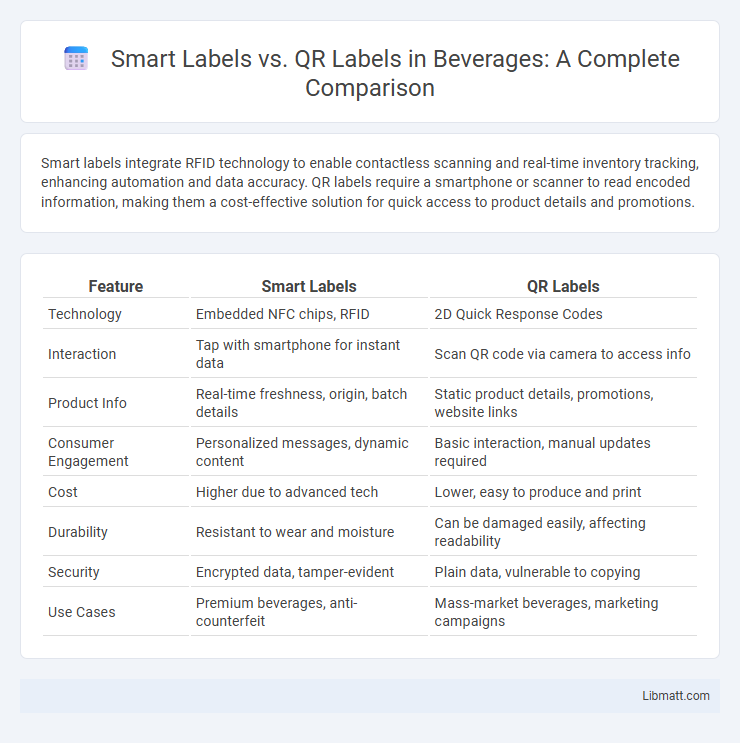Smart labels integrate RFID technology to enable contactless scanning and real-time inventory tracking, enhancing automation and data accuracy. QR labels require a smartphone or scanner to read encoded information, making them a cost-effective solution for quick access to product details and promotions.
Table of Comparison
| Feature | Smart Labels | QR Labels |
|---|---|---|
| Technology | Embedded NFC chips, RFID | 2D Quick Response Codes |
| Interaction | Tap with smartphone for instant data | Scan QR code via camera to access info |
| Product Info | Real-time freshness, origin, batch details | Static product details, promotions, website links |
| Consumer Engagement | Personalized messages, dynamic content | Basic interaction, manual updates required |
| Cost | Higher due to advanced tech | Lower, easy to produce and print |
| Durability | Resistant to wear and moisture | Can be damaged easily, affecting readability |
| Security | Encrypted data, tamper-evident | Plain data, vulnerable to copying |
| Use Cases | Premium beverages, anti-counterfeit | Mass-market beverages, marketing campaigns |
Understanding Smart Labels: Definition and Features
Smart labels are advanced labeling solutions embedded with RFID (Radio Frequency Identification) chips or NFC (Near Field Communication) technology, enabling wireless data exchange and real-time tracking. These labels store dynamic product information, such as manufacturing details, expiration dates, and supply chain data, enhancing inventory management and anti-counterfeiting measures. Unlike QR labels, which require optical scanning, smart labels offer seamless interaction through radio waves, allowing for faster processing and greater data capacity in various industries.
What are QR Labels? Core Concepts and Uses
QR labels are two-dimensional barcodes that store data readable by smartphones or QR scanners, enabling quick access to information, websites, or product details. These labels utilize a matrix of black and white squares to encode data, facilitating inventory management, marketing campaigns, and asset tracking. You can enhance customer engagement and streamline operations by integrating QR labels into packaging or promotional materials.
Technology Behind Smart Labels vs QR Codes
Smart labels integrate Near Field Communication (NFC) or Radio Frequency Identification (RFID) technology, enabling wireless data transfer through embedded microchips and antennas. QR labels rely on optical scanning of two-dimensional barcodes composed of black and white squares that store data readable by smartphone cameras or barcode readers. Both technologies enhance product information access but differ in data capacity, interaction methods, and application scope.
Applications: Where Are Smart Labels and QR Labels Used?
Smart labels are widely used in retail, logistics, and healthcare for inventory tracking, anti-counterfeiting, and patient safety, leveraging RFID technology for real-time data access. QR labels are prevalent in marketing, product packaging, and event management, enabling consumers to instantly access websites, promotions, or detailed product information through smartphone scanning. Your choice between smart labels and QR labels depends on the need for automated data capture or interactive consumer engagement.
Security and Data Protection: A Comparative Analysis
Smart labels incorporate embedded chips with encryption capabilities, offering enhanced security features and safeguarding sensitive data through secure authentication protocols. QR labels, while widely accessible and easy to generate, rely heavily on external scanning devices and apps, making them more vulnerable to tampering and unauthorized access. To protect your information effectively, smart labels provide a robust solution with superior data protection and fraud prevention compared to standard QR codes.
User Experience: Ease of Use and Accessibility
Smart labels offer enhanced ease of use by automatically interacting with devices via NFC technology, requiring just a tap for instant access to information without opening any app. QR labels depend on a smartphone camera and scanning apps, which may slow down user experience and limit accessibility for users unfamiliar with scanning processes. Your choice between smart and QR labels significantly impacts accessibility, with smart labels providing a seamless, intuitive interface for quick information retrieval.
Cost Comparison: Smart Labels vs QR Labels
Smart labels generally incur higher costs than QR labels due to embedded technologies like RFID chips and sensors, which add to manufacturing expenses. QR labels, requiring only printed codes readable by smartphones, present a more affordable option for tracking and information sharing. Your choice depends on budget constraints and the level of functionality needed for your application.
Integration with Supply Chain and Inventory Systems
Smart labels, equipped with RFID technology, offer seamless integration with supply chain and inventory systems by enabling real-time tracking and automated data capture, significantly improving visibility and operational efficiency. QR labels require manual scanning and smartphone or scanner interaction, which can slow down data collection and limit automation in complex logistics environments. Companies leveraging smart labels experience enhanced accuracy in inventory management and streamlined workflows compared to the more manual process involved with QR labels.
Future Trends in Labeling Technology
Smart labels integrating NFC and RFID technologies are poised to dominate future labeling due to their enhanced interactivity and real-time data capabilities. QR labels remain valuable for their simplicity and widespread adoption but may evolve by embedding augmented reality features to enrich consumer engagement. The convergence of IoT connectivity with smart labeling will drive personalized marketing and supply chain efficiency, making these technologies pivotal in forthcoming labeling innovation.
Choosing the Right Label: Key Factors to Consider
Choosing the right label between smart labels and QR labels depends on factors such as data storage capacity, interaction complexity, and user engagement goals. Smart labels offer enhanced functionalities like real-time tracking and sensor integration, ideal for supply chain management and inventory control. QR labels provide quick access to web content with simple scanning, suitable for marketing campaigns and product information dissemination.
Smart labels vs QR labels Infographic

 libmatt.com
libmatt.com